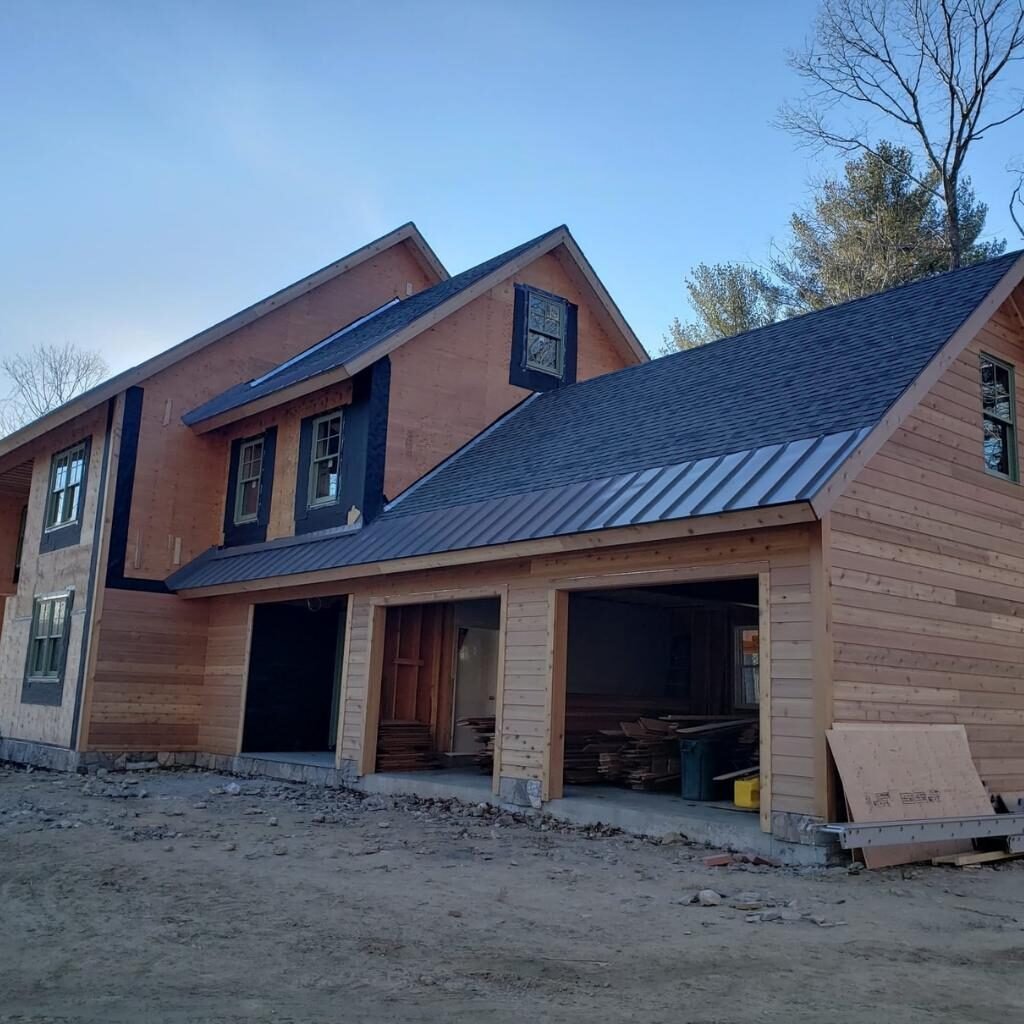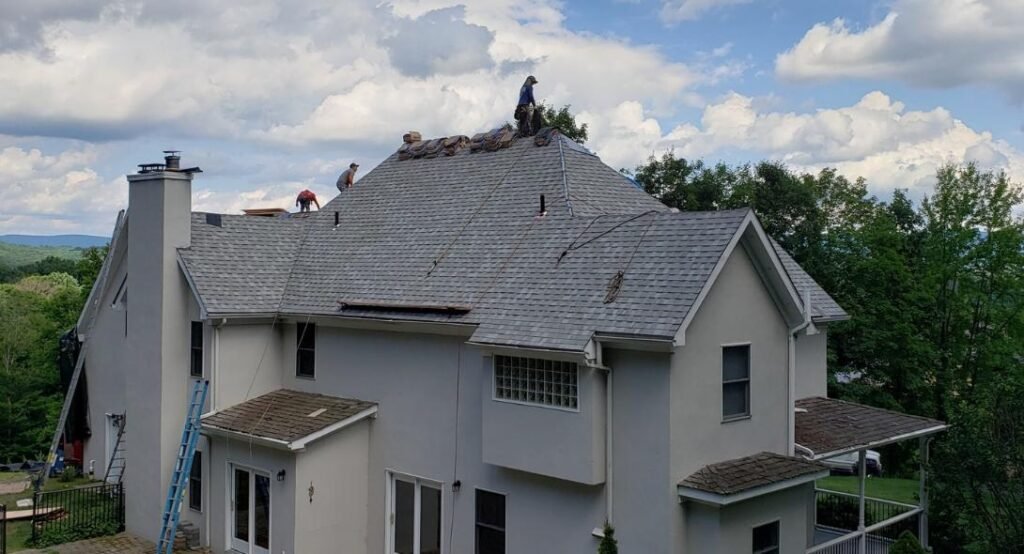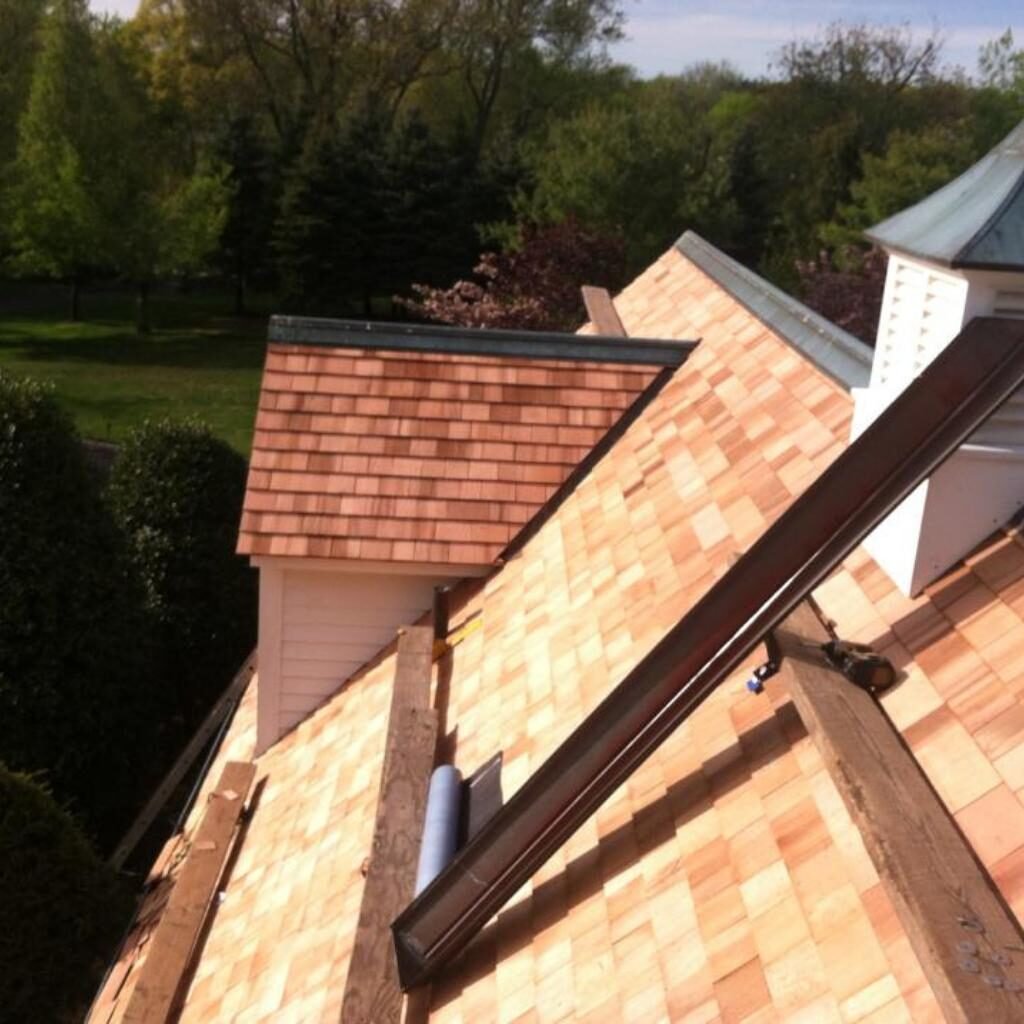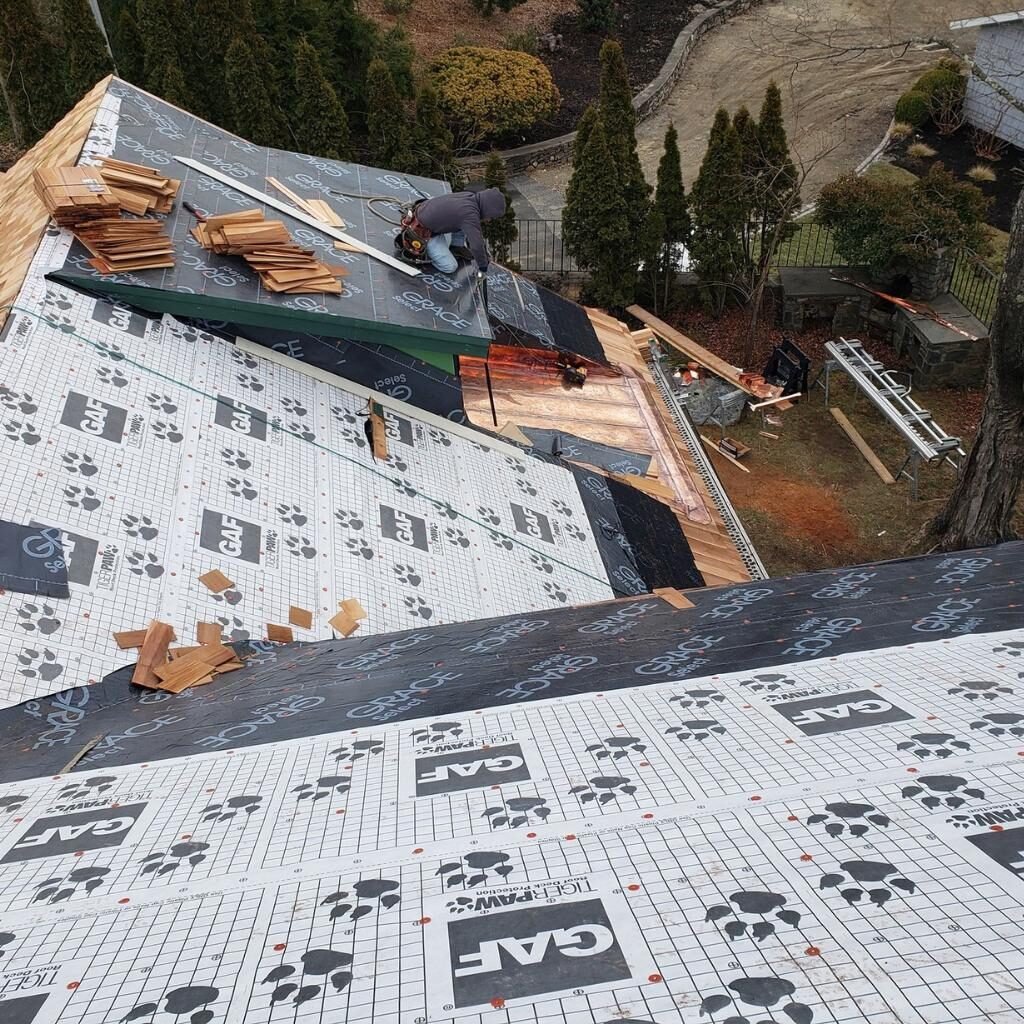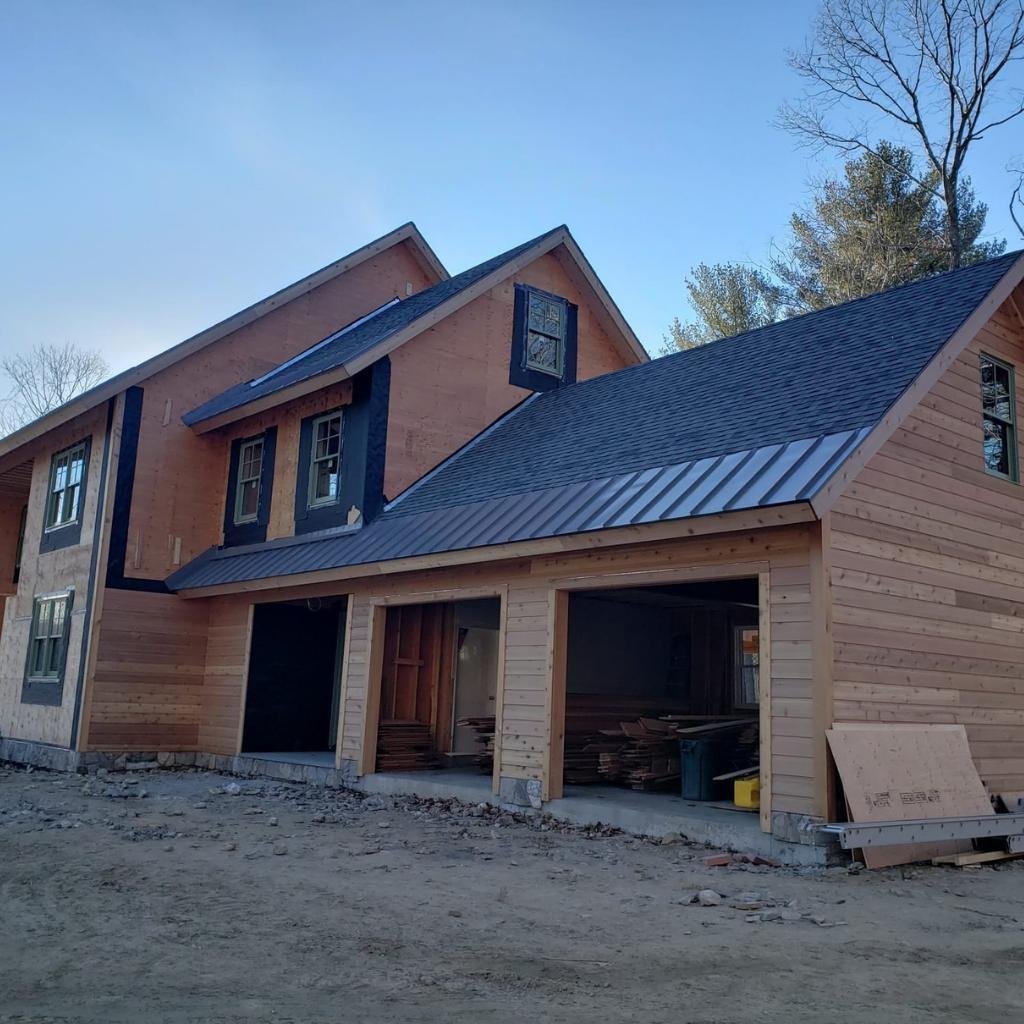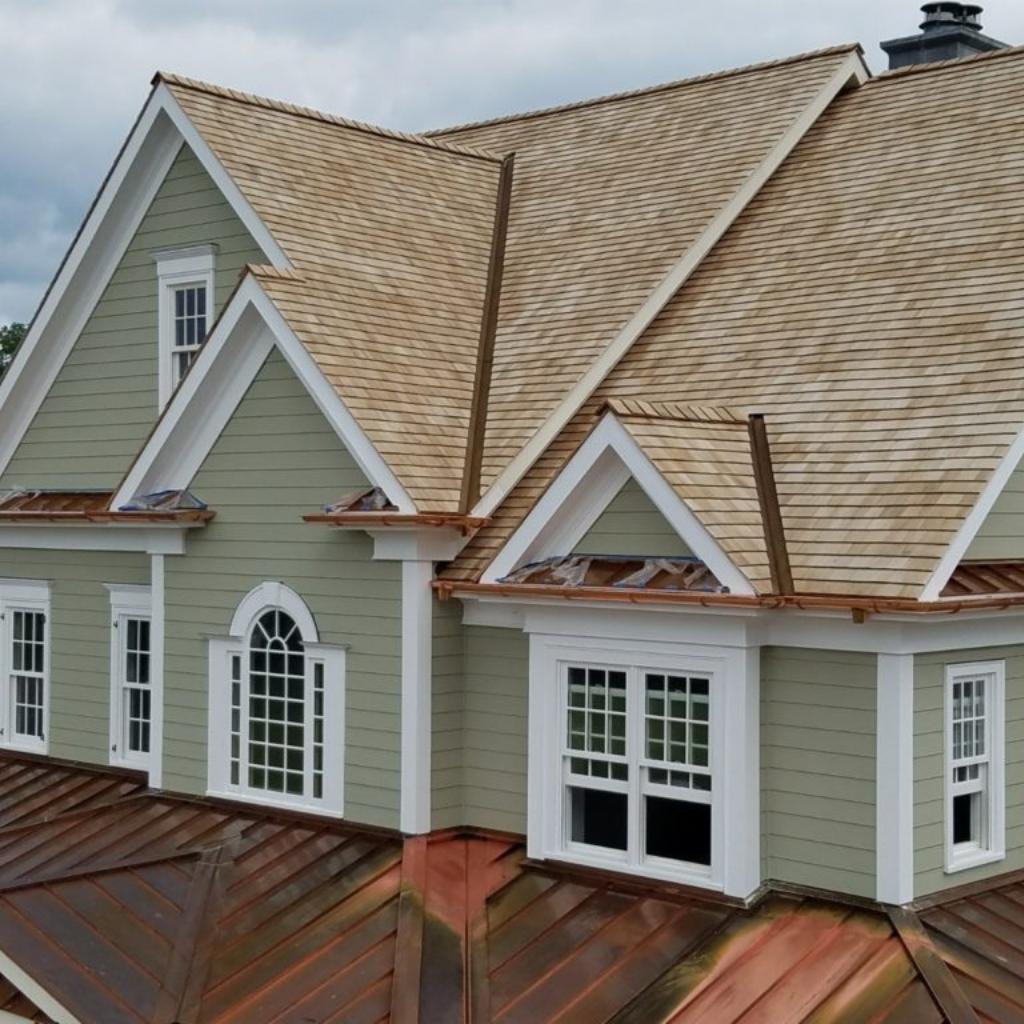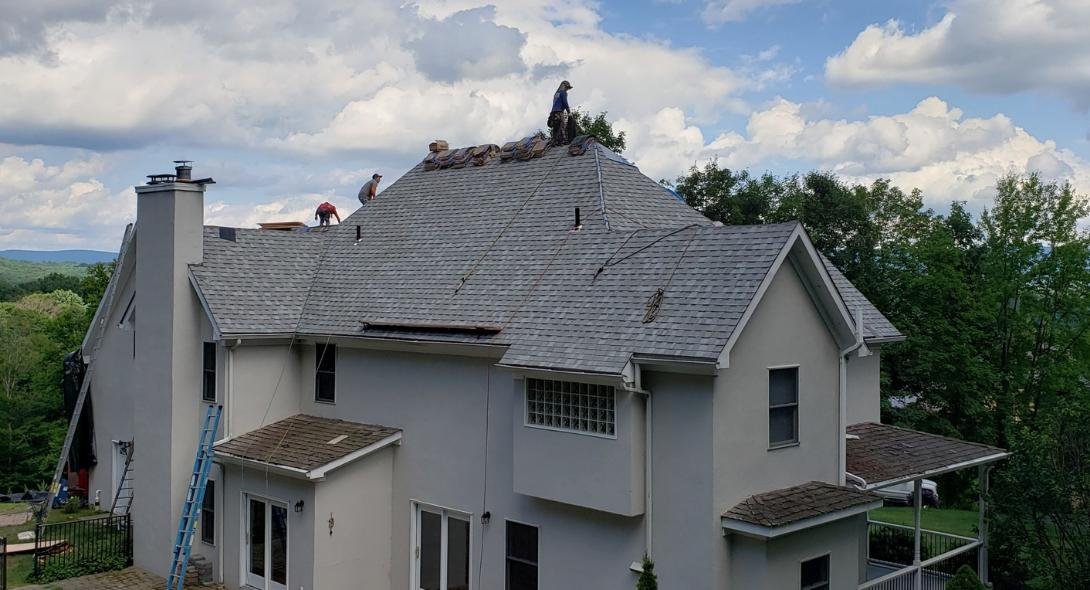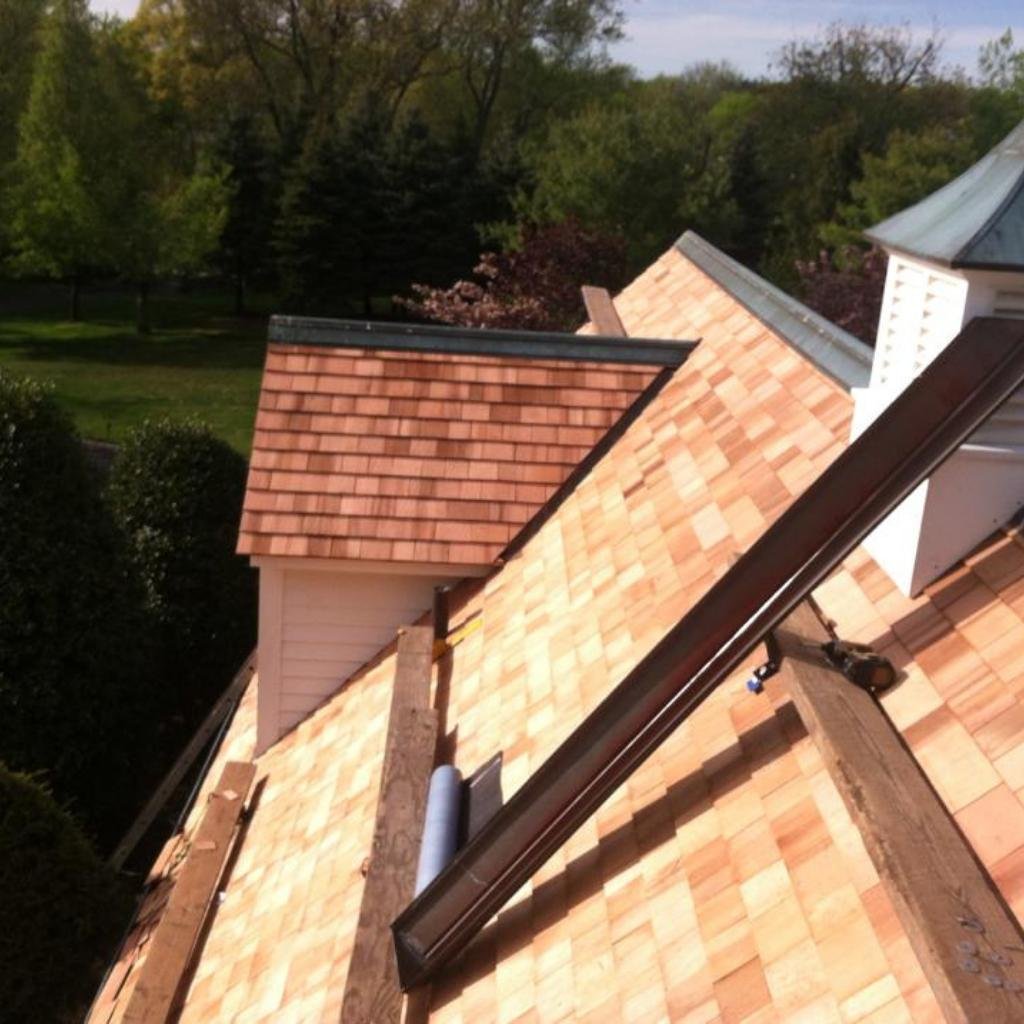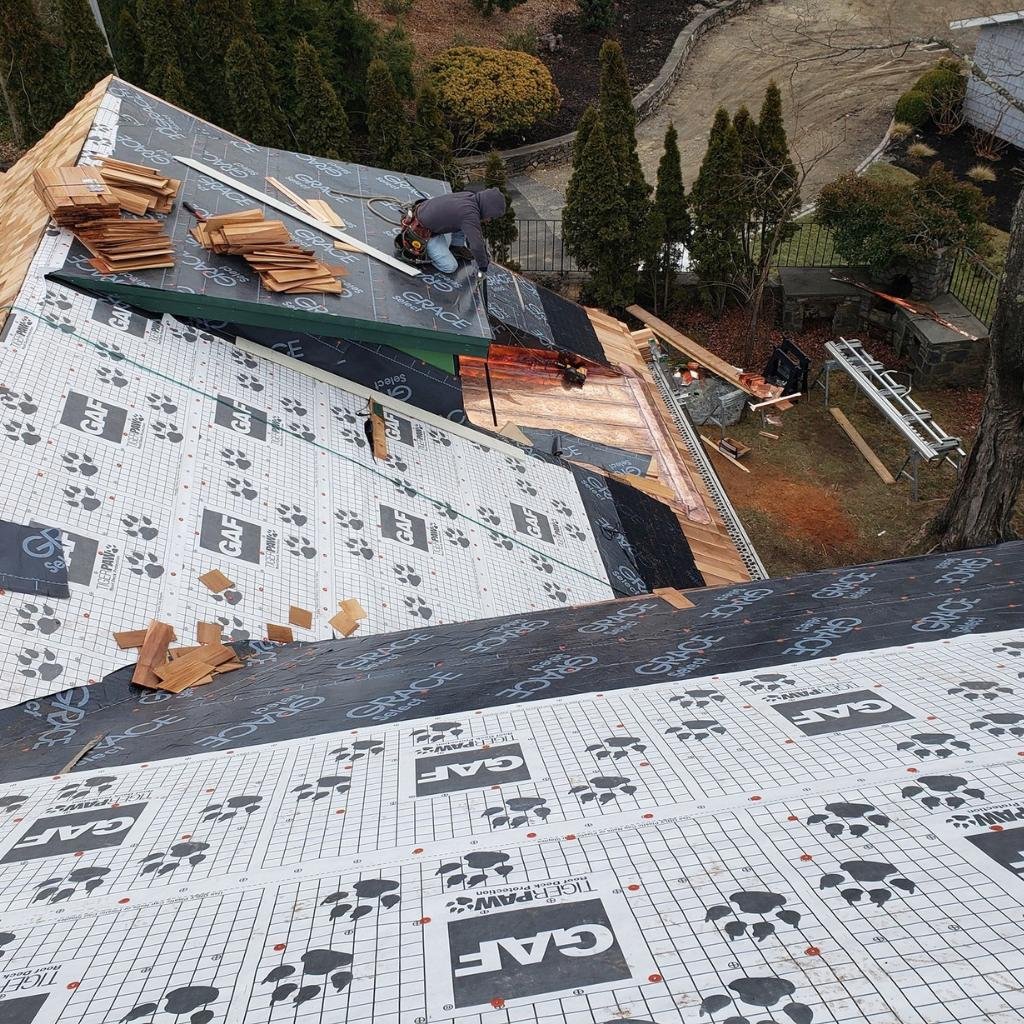Connecticut Wind Damage Restoration Experts
Connecticut’s geographic location exposes homes to powerful wind events throughout the year. Severe thunderstorms bring straight-line winds exceeding 60 mph, nor’easters produce sustained gale-force winds, and occasional tropical systems deliver hurricane-force gusts. These wind forces test every vulnerable point in your roofing system, often causing damage that progresses from minor problems to serious failures.
At American Quality Roofing and Siding, we’ve spent over 25 years repairing wind damage throughout Connecticut. Our specialists understand that wind affects roofing systems differently than other damage types. Uplift forces work beneath shingles, suction pressures separate flashing connections, and flying debris creates impacts that compromise multiple roof areas simultaneously. Identifying all wind damage requires expertise that goes beyond obvious missing shingles or visible holes.
Many homeowners underestimate wind damage severity, noticing only the most apparent problems while missing underlying issues that will cause future failures. Lifted shingles may reseal temporarily, creating false security while compromised adhesion leaves your roof vulnerable to the next wind event. Subtle flashing separations may not leak immediately but create entry points that allow water intrusion during the next rainstorm.
Our comprehensive wind damage assessment identifies all affected areas, from obvious surface damage to hidden structural impacts. We provide the professional repairs necessary to restore complete protection and work directly with insurance companies to ensure you receive appropriate coverage for all necessary restoration work. Connecticut homeowners trust our expertise to identify problems others miss and deliver lasting repairs that withstand our challenging climate.
Free Estimates – Contact Us Today
Understanding Wind Damage
How Wind Forces Damage Connecticut Roofs
Wind creates unique damage patterns through uplift, suction, and impact forces. Understanding these mechanisms helps homeowners recognize problems and appreciate the importance of professional assessment.
Uplift Forces: Wind passing over your roof creates negative pressure that pulls upward on roofing materials. This uplift force is strongest at roof edges, corners, and ridges where wind acceleration is greatest. Shingles designed to withstand normal conditions can lift or tear completely away when uplift exceeds their fastening strength or adhesive seal capacity.
Suction Pressures: Wind doesn’t just blow across roofs; it creates complex pressure patterns including powerful suction zones. These negative pressures separate flashing, lift membrane systems, and work beneath shingle edges. Suction forces can compromise roofing materials without leaving obvious external evidence until the next weather event reveals the damage.
Impact Damage: Wind-borne debris ranging from tree branches to patio furniture creates impacts that puncture, crack, or dislodge roofing materials. Even small debris traveling at high speeds can cause significant damage. Impact locations may be scattered across your roof rather than concentrated in specific areas, requiring comprehensive inspection to identify all affected zones.
Progressive Failures: Wind damage often initiates cascading failures. One lifted shingle exposes underlayment and adjacent shingles to increased wind forces. During subsequent storms, damage spreads as compromised areas cannot resist forces they were designed to withstand. What begins as minor damage can quickly escalate to extensive failures requiring major repairs.
Thermal Seal Compromise: Asphalt shingles rely on thermal adhesive strips that bond to underlying shingles when heated by the sun. Wind forces that lift shingles even temporarily can break these seals. Once broken, seals rarely re-establish properly, leaving shingles vulnerable to lower wind speeds than they originally resisted.
Fastener Pullout: Extreme wind forces can pull fasteners through shingles or decking materials. These failures often occur in patterns related to wind direction and roof geometry. Pulled fasteners leave shingles inadequately attached even if they remain in place visually, creating vulnerabilities during future wind events.
Edge and Transition Damage: Areas where roof planes meet, edges transition to other materials, or penetrations break the roof surface experience concentrated wind forces. These locations sustain disproportionate damage and require special attention during assessment and repair.
Our experience with Connecticut wind patterns means we know where damage concentrates and what signs indicate serious problems versus minor issues that don’t compromise roof integrity.
Signs of Wind Damage
Identifying Wind Damage to Your Roof
Wind damage ranges from obvious to subtle. Recognizing warning signs helps homeowners seek professional assessment before minor problems become major failures.
Obvious Indicators:
- Missing shingles or large sections torn from roof
- Visible holes or punctures from debris impact
- Shingles lying in your yard or neighboring properties
- Damaged or missing ridge caps
- Torn or separated flashing visible from ground level
- Visible roof deck or underlayment exposure
Subtle Warning Signs:
- Lifted shingle corners or edges
- Shingles with creased or bent appearance
- Asymmetric granule loss patterns
- Loose or displaced shingles that haven’t blown off completely
- Curled or cupped shingle edges
- Visible nail heads where shingles have lifted
Flashing and Trim Indicators:
- Separated or loose metal flashing
- Gaps between flashing and roof surfaces
- Missing or damaged drip edge
- Loose fascia or soffit panels
- Separated chimney counter-flashing
- Damaged or missing vent boots
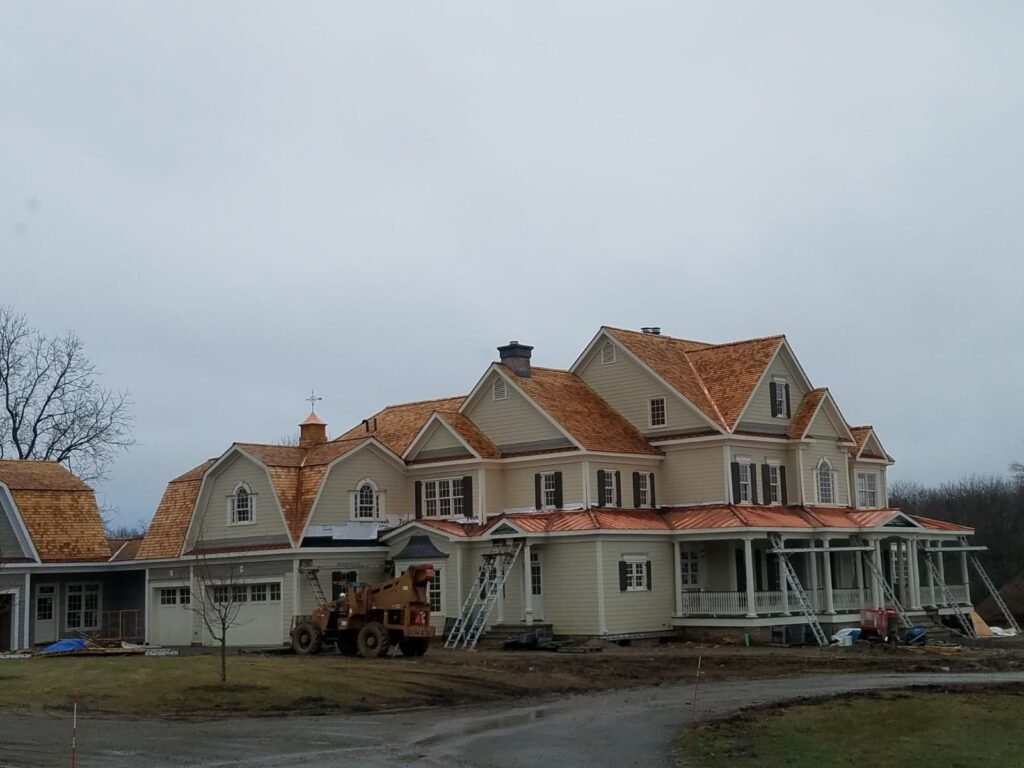
Structural Concerns:
- Sagging roof sections or visible dips
- Unusual sounds from attic during subsequent wind
- Cracks in exterior walls near roofline
- Separated connections at roof-to-wall transitions
- Visible movement in roof structure during wind
- Interior ceiling cracks appearing after wind events
Secondary Damage Evidence:
- Water stains appearing after wind events (indicating lifted shingles allowing rain entry)
- Increased attic ventilation (suggesting separated components)
- Higher energy bills (indicating compromised building envelope)
- Debris accumulation in gutters (suggesting material breakdown)
Neighborhood Indicators:
- Multiple neighbors reporting wind damage
- Roofing contractors actively working nearby
- Visible damage to surrounding properties
- Storm debris scattered throughout area
Not all wind damage is immediately apparent. Professional inspection after significant wind events identifies problems before they cause leaks or progress to more extensive failures. Connecticut’s frequent wind events mean damage can accumulate over time, with each storm worsening existing problems until major failures occur.
Connecticut Wind Patterns and Risk
Wind Threats Facing Connecticut Roofs
Connecticut’s location subjects homes to various wind threats throughout the year. Understanding these patterns helps homeowners recognize risk and respond appropriately.
Severe Thunderstorm Winds: Summer months bring powerful thunderstorms producing straight-line winds often exceeding 60 mph. These brief but intense events create sudden uplift forces and propel debris at high speeds. Microbursts and downbursts can produce localized wind speeds approaching 100 mph, causing catastrophic damage in narrow paths.
Nor’easter Systems: These powerful coastal storms bring sustained winds affecting Connecticut for extended periods, sometimes days. Prolonged wind exposure tests roofing systems differently than brief thunderstorm gusts. Materials must resist constant forces rather than momentary peaks, and cumulative exposure can cause failures that shorter events wouldn’t produce.
Tropical Systems: While direct hurricane hits are uncommon, tropical storm remnants regularly affect Connecticut. These systems produce widespread wind damage across large areas, often saturating repair contractor capacity and creating extended wait times for restoration services.
Winter Wind Events: Cold season wind storms combine powerful gusts with freezing temperatures. Brittle roofing materials resist wind forces less effectively in extreme cold, and ice accumulation adds weight while wind forces create additional stress on structures.
Topographic Influences: Connecticut’s varied terrain creates localized wind acceleration zones. Properties on hilltops, near large open areas, or along coastlines experience higher wind speeds than surrounding regions. These locations face increased damage risk requiring enhanced installation methods and more durable materials.
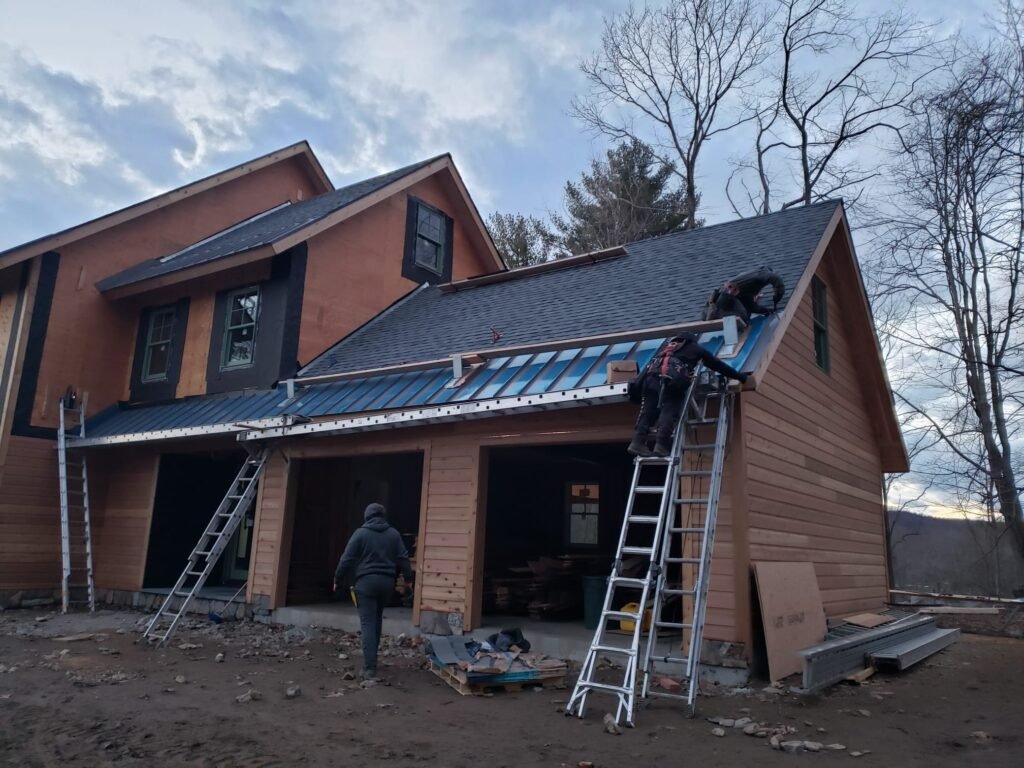
Geographic Vulnerability Zones: Coastal Connecticut faces persistent salt-laden winds that corrode fasteners and metal components, weakening systems before major wind events occur. Inland areas experience different patterns with valley channeling effects and terrain-influenced wind acceleration.
Direction and Duration Factors: Wind direction influences which roof areas sustain the most damage. South and west-facing slopes typically face greatest exposure in Connecticut. Duration matters significantly; brief high-speed gusts cause different damage than sustained moderate winds over hours or days.
Seasonal Accumulation: Connecticut roofs rarely experience just one wind event. Multiple storms throughout the year create cumulative damage. A roof surviving spring thunderstorms with minor issues may fail completely during fall nor’easters because accumulated damage has compromised its resistance.
Understanding these patterns explains why professional assessment after any significant wind event is crucial. Each storm may cause hidden damage that becomes critical during subsequent events.
quality Services
We Provide Quality
Roofing Services Throughout CT
5 Star Reviews
Projects
Teams available
Free Estimate – Contact Us Today
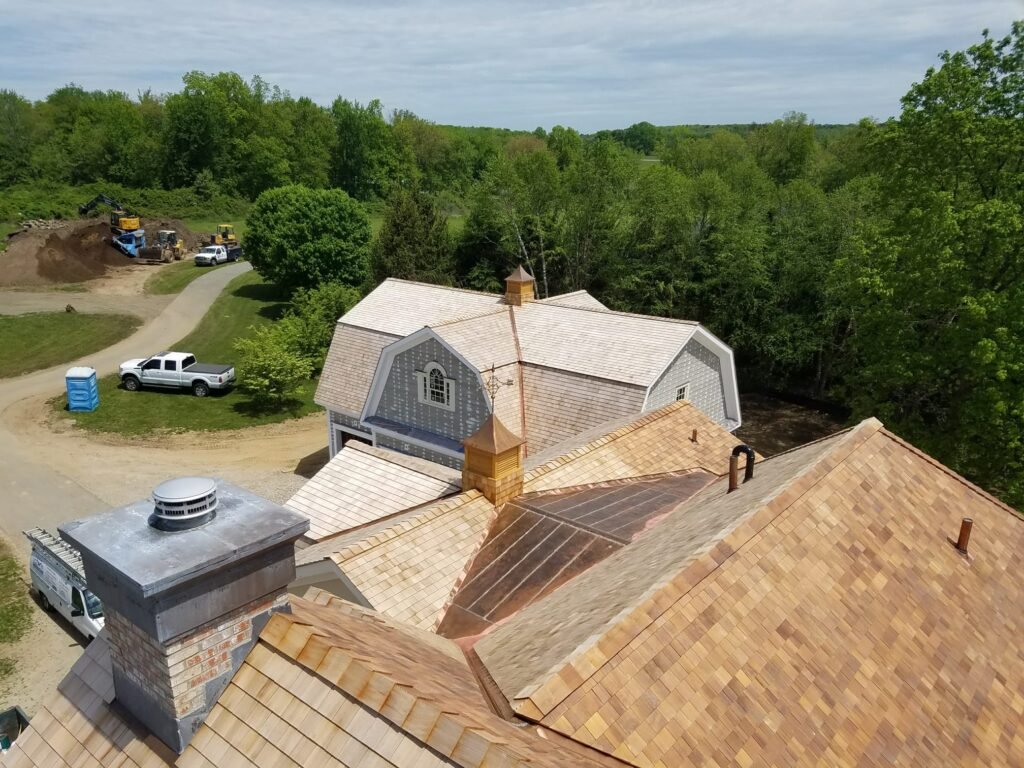
Wind Damage Insurance Claims
Maximizing Your Wind Damage Insurance Coverage
Wind damage insurance claims require proper documentation and understanding of policy terms. Our extensive claims experience helps Connecticut homeowners receive appropriate coverage.
Coverage Determination: Most homeowner policies cover wind damage as a covered peril. However, policies vary in deductibles, coverage limits, and specific exclusions. Understanding your policy terms before filing claims helps set realistic expectations and ensures proper documentation.
Documentation Requirements: Insurance companies need substantial evidence of wind damage. Our professional documentation includes photographs showing damage patterns consistent with wind forces, detailed reports specifying all affected areas, measurements of damaged zones, and expert assessment explaining how wind created observed damage.
Proving Wind Causation: Insurance adjusters must confirm damage resulted from wind rather than age, improper installation, or lack of maintenance. Our documentation demonstrates wind-specific damage patterns, provides weather event verification, and explains damage mechanisms that distinguish wind impacts from other causes.
Time-Sensitive Reporting: Policies typically require prompt damage reporting after wind events, often within 30-90 days. Delays can complicate claims or result in denial. Immediate professional assessment after significant wind ensures timely reporting and proper documentation while evidence remains clear.
Adjuster Inspections: Insurance adjusters evaluate damage to determine coverage. However, adjusters may lack roofing expertise or miss subtle damage indicators. Our presence during adjuster inspections ensures comprehensive damage identification and appropriate repair specifications.
Repair vs. Replacement Coverage: Determining whether insurance covers repair or replacement depends on damage extent and policy terms. Connecticut building codes may mandate replacement when damage affects specified roof percentages. We help demonstrate whether repair is adequate or replacement is necessary.
Matching and Code Requirements: When replacement is necessary, matching existing materials may be impossible if products are discontinued. Insurance policies typically cover costs to replace larger areas when matching isn’t feasible. Additionally, code compliance may require upgrades beyond simple replacement. We document these requirements and ensure coverage includes necessary work.
Supplement Documentation: Additional damage often becomes apparent during repairs. We document these discoveries and submit supplemental claims ensuring complete coverage rather than leaving you with unexpected costs.
Depreciation Considerations: Policies may apply depreciation to older roofs, affecting payout amounts. Understanding how depreciation impacts your coverage helps set financial expectations. We explain these factors and help you make informed decisions.
Denial Prevention: We understand common reasons insurance companies deny wind damage claims. Our documentation and presentation methods address these concerns proactively, significantly improving approval likelihood and appropriate coverage.
Our claims assistance has helped hundreds of Connecticut homeowners navigate wind damage insurance processes, ensuring they receive the coverage their policies provide.surance processes and receive appropriate coverage for hail damage repairs. This expertise provides significant value beyond our installation and repair services.
Emergency Wind Damage Response
Immediate Protection After Wind Events
Wind damage often requires urgent response to prevent further problems. Our emergency services provide immediate protection when Connecticut storms compromise your roof.
24/7 Emergency Availability: Wind damage doesn’t respect business hours. Our emergency response line (203) 470-0974 connects you with specialists 24/7, ensuring you receive help whenever wind damages your roof.
Rapid Assessment Deployment: We respond quickly to wind damage calls, typically arriving within hours during emergency situations. Weather permitting, we assess damage immediately and implement protective measures the same day.
Emergency Tarping Services: When wind damage creates openings exposing your home’s interior, professional tarping prevents water intrusion and further damage. Our tarping techniques secure compromised areas and withstand subsequent weather until permanent repairs can be completed.
Temporary Repairs: Some wind damage situations benefit from temporary repairs beyond tarping. We implement solutions that restore basic protection, prevent damage progression, and maintain security until permanent restoration is possible.
Debris Removal: Wind events often leave debris on roofs that poses continued threats. Heavy branches, displaced equipment, or accumulated materials can cause additional damage if not removed promptly. We safely clear debris as part of emergency response.
Safety Hazard Mitigation: Damaged roofs can create dangerous conditions. Loose materials may fall, structural instability may exist, or electrical hazards may be present. Our emergency assessment identifies these dangers and implements measures to protect your family and property.
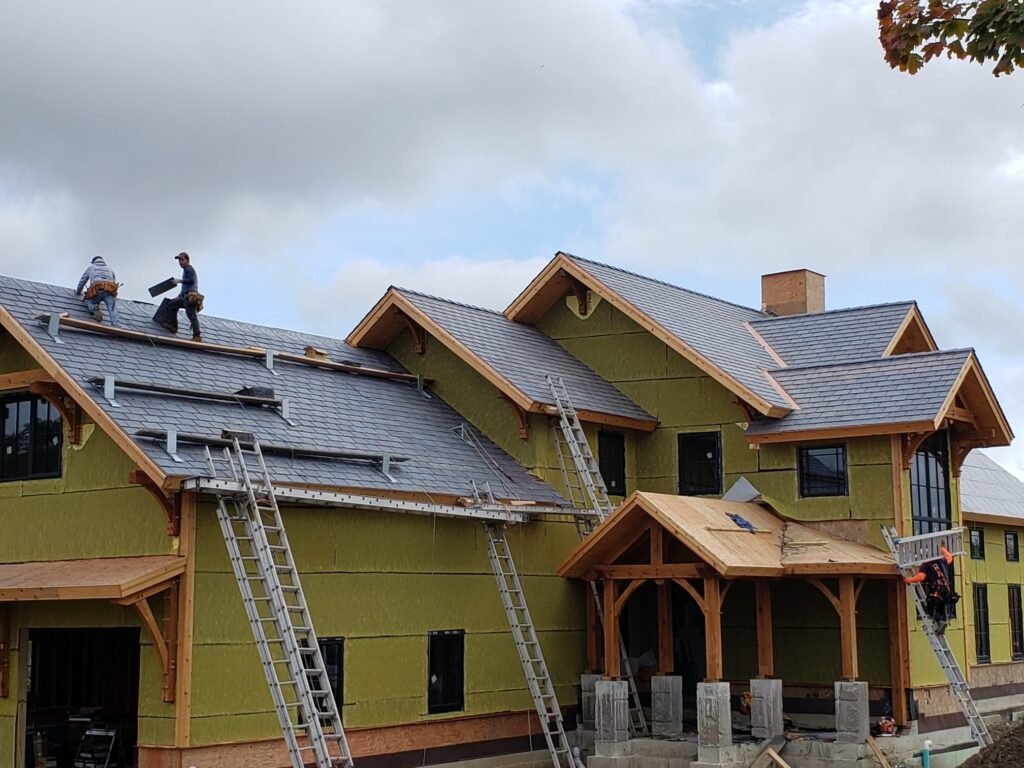
Priority Repair Scheduling: Emergency wind damage cases receive priority for permanent repairs. We understand extended vulnerability increases risk and work efficiently to restore complete protection quickly.
Communication and Coordination: We keep you informed throughout emergency response, explaining actions taken, what comes next, and realistic timelines. If coordination with other contractors is necessary for electrical, structural, or interior repairs, we facilitate these connections.
Insurance Notification Assistance: During emergency response, we help you understand insurance notification requirements and provide documentation supporting your claim. This immediate attention ensures compliance with policy terms while protecting your home.
Our emergency response has protected hundreds of Connecticut homes after wind damage, minimizing secondary problems and providing peace of mind during stressful situations.th your roof’s integrity and your insurance claim interests.
Preventing Future Wind Damage
Wind-Resistant Roofing Solutions
While wind cannot be prevented, proper materials, installation techniques, and maintenance significantly reduce damage severity during future wind events.
Enhanced Fastening Methods: Standard installation may use minimum required fasteners, but enhanced patterns provide superior wind resistance. Additional fasteners in high-wind zones, upgraded fastener types, and proper placement patterns significantly improve uplift resistance.
High-Wind Rated Materials: Shingles tested and rated for high wind speeds offer better performance than standard products. Class H ratings indicate resistance to winds up to 150 mph when properly installed. These materials cost modestly more but provide substantially improved protection.
Sealed Shingle Systems: Some shingle products feature enhanced adhesive systems providing superior wind resistance. These materials create stronger bonds between courses, requiring higher wind speeds to initiate lifting or failure.
Proper Edge Detailing: Roof edges experience highest wind forces and require special attention. Enhanced edge fastening, properly installed drip edge, and secure starter courses significantly improve wind resistance at these vulnerable locations.
Quality Underlayment: Premium synthetic underlayment provides better wind resistance than standard felt products. Enhanced underlayment resists tearing, maintains integrity when exposed during shingle loss, and provides secondary protection during wind events.
Secure Flashing Installation: Flashing connections must resist both uplift and suction forces. Proper fastening, adequate overlap, and quality sealants ensure flashing remains secure during high winds. Mechanical fastening is superior to adhesive-only installations in wind-prone areas.
Regular Maintenance Impact: Well-maintained roofs resist wind damage better than neglected systems. Annual inspections identify loose shingles, failing seals, and other vulnerabilities before wind events exploit these weaknesses. Prompt minor repairs prevent progression to major failures.
Structural Considerations: Adequate roof deck fastening, proper rafter connections, and sufficient bracing improve overall wind resistance. When replacement is necessary, addressing structural enhancements provides long-term protection benefits.
Vegetation Management: Tree trimming eliminates the source of most wind-driven debris damage. Maintaining proper clearance prevents branches from impacting roofs during wind events and reduces debris accumulation that can create additional problems.
If you’re repairing or replacing wind-damaged roofing, implementing these enhancements provides value through reduced future damage risk and improved storm performance.y when exposed during shingle loss, and provides secondary protection during wind events.
Wind Damage Repair vs. Replacement
Choosing the Right Restoration Approach
After wind damage assessment, determining whether to repair or replace your roof requires careful consideration of multiple factors.
Damage Distribution Analysis
Roof Age Evaluation
Insurance Coverage Factors
Material Matching Challenges
Hidden Damage Considerations
Code Compliance Requirements
Performance Expectations
Future Storm Resistance
Long-Term Value
Don’t Delay Professional Repair
Our Wind Damage Repair Process
Professional Wind Damage Restoration
Our systematic approach ensures thorough assessment, appropriate repairs, and complete restoration of your roof’s wind resistance.
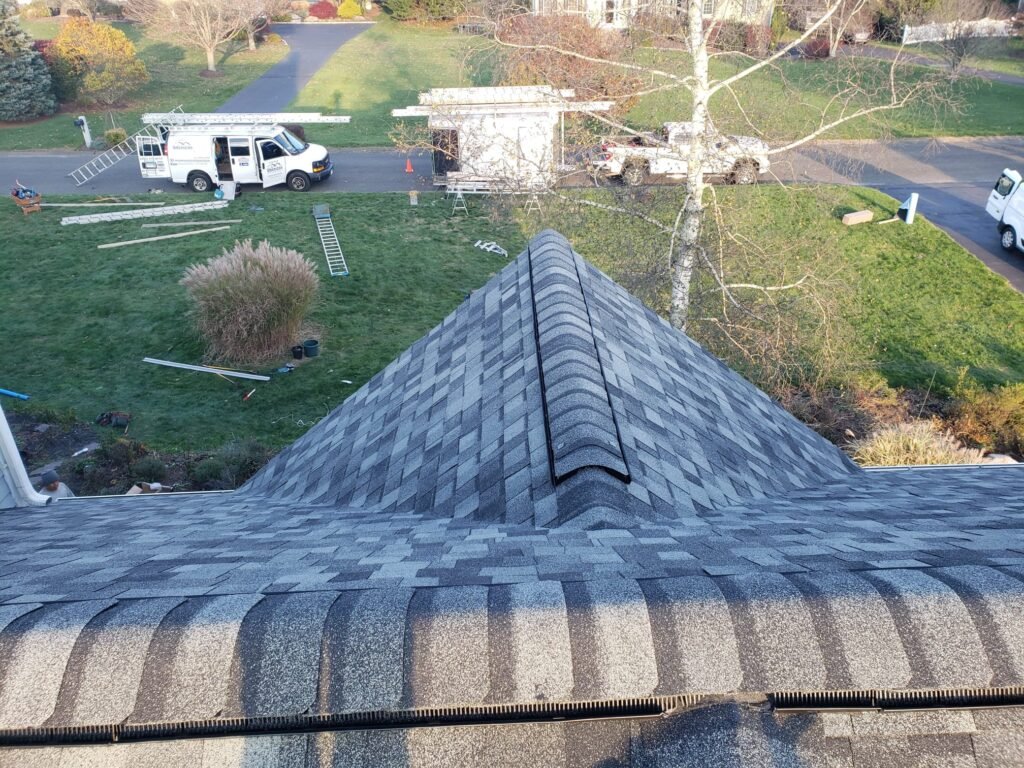
omprehensive Wind Damage Assessment
Our specialists examine every roof area, identifying all wind damage including subtle indicators others miss. We document damage patterns, assess severity, and determine whether repair or replacement provides the best solution.
Professional Documentation
We create detailed photographic evidence and written reports specifying all damage. This documentation supports insurance claims and provides clear records of wind impact and necessary restoration work.
Insurance Coordination
We communicate directly with your insurance company, submit professional documentation, and work with adjusters during inspections. Our expertise ensures all damage is recognized and appropriate coverage is provided.
Detailed Restoration Planning
Based on assessment findings and insurance approval, we develop comprehensive specifications for all work. You’ll understand exactly what will be done, what materials will be used, and realistic completion timelines.
Quality Material Procurement
We source premium materials appropriate for Connecticut’s wind conditions. When enhanced wind-resistant options make sense, we explain benefits and help you select materials providing optimal protection.
Expert Installation
Our factory-certified crews complete all work following enhanced wind-resistant installation techniques. We use proper fastening patterns, secure all vulnerable areas, and ensure quality throughout the restoration.
Final Verification and Warranty
We conduct thorough quality inspection, verify your complete satisfaction, and provide comprehensive warranty documentation covering both materials and workmanship. Your restored roof will resist Connecticut’s wind forces reliably.
Why Choose Us for Wind Damage Repair
Connecticut’s Wind Damage Restoration Specialists
25 Years of Wind Damage Experience: Since 1999, we’ve repaired wind damage from countless Connecticut storms. This extensive experience means we recognize all wind damage patterns and know how to restore complete protection effectively.
Specialized Assessment Expertise: Our inspectors understand wind force mechanics and resulting damage patterns. This specialized knowledge ensures we identify all affected areas, including subtle damage others overlook.
Proven Insurance Success: We’ve successfully managed hundreds of wind damage insurance claims throughout Connecticut. Our professional documentation and adjuster communication help homeowners receive appropriate coverage for necessary repairs.
Factory-Certified Installation: Our certifications with GAF Materials Corporation and as ShingleMaster™ CertainTeed Select contractors ensure repairs meet the highest standards. These certifications provide access to premium materials and extended warranty programs.
24/7 Emergency Response: Wind damage emergencies receive immediate attention. Our around-the-clock availability ensures you receive help when you need it most, minimizing secondary damage and providing peace of mind.
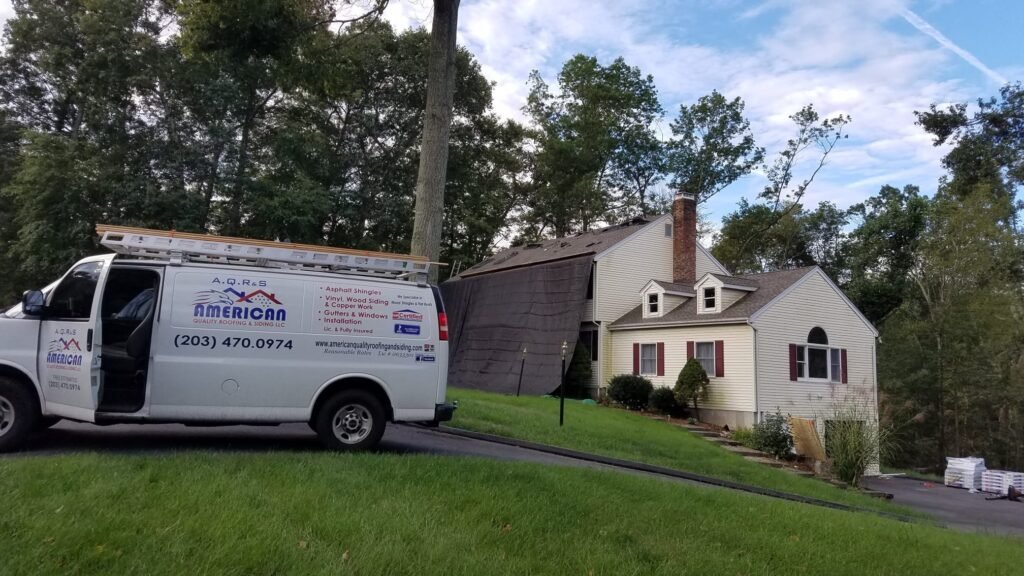
Enhanced Wind-Resistant Techniques: We implement installation methods exceeding standard requirements. Enhanced fastening patterns, secure edge details, and proper material integration provide superior wind resistance.
Complete Project Management: From emergency response through final warranty documentation, we handle every restoration aspect. This comprehensive management eliminates stress and ensures efficient, quality completion.
Licensed and Insured Protection: Connecticut License #HIC 0633301 and comprehensive insurance coverage protect you throughout restoration. This licensing and insurance provides accountability and security.
Quality Without Compromise: We use only premium materials and proven techniques. Shortcuts might reduce immediate costs but lead to recurring problems. Our quality focus provides lasting value and reliable protection.
FAQs
Common Questions About Wind Damage Roof Repair
Wind damage raises important questions about assessment, repairs, and insurance coverage. Over our 25 years serving Connecticut families, we’ve helped hundreds of homeowners restore roofs after wind events ranging from severe thunderstorms to nor’easters and tropical systems. Below are the most common concerns homeowners have about wind damage to their roofs. If you don’t see your specific question answered here, our team is always available to provide personalized guidance for your situation.
Wind Damage To your Roof? Get Professional Assessment Now
Wind damage compromises your roof’s ability to protect your home and often worsens rapidly during subsequent storms. Don’t risk further damage or insurance claim complications by delaying professional assessment.
Our wind damage specialists provide thorough evaluation, professional documentation, and complete restoration services. With over 25 years of experience and 778+ successfully completed projects, we have the expertise to identify all damage and ensure appropriate insurance coverage.
We respond 24/7 to wind damage emergencies, providing immediate protection and working directly with insurance companies to streamline claims and ensure you receive appropriate coverage for necessary repairs.
- Licensed and Insured – CT #HIC 0633301
- Factory Certified by GAF Materials Corporation
- ShingleMaster™ CertainTeed Select Contractors
- A+ Better Business Bureau Rating

